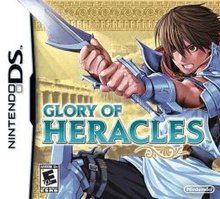
The Mana series, known in Japan as Seiken Densetsu, is a high fantasy action role-playing game series created by Koichi Ishii, with development formerly from Square, and is currently owned by Square Enix. The series began in 1991 as Final Fantasy Adventure, a Game Boy handheld side story to Square's flagship franchise Final Fantasy. The Final Fantasy elements were subsequently dropped starting with the second installment, Secret of Mana, in order to become its own series. It has grown to include games of various genres within the fictional world of Mana, with recurring stories involving a world tree, its associated holy sword, and the fight against forces that would steal their power. Several character designs, creatures, and musical themes reappear frequently.
Dragon Quest Monsters is a spin-off series of the Dragon Quest games. Primarily developed by Tose and published by Square Enix, it sets the player in a medieval/fantasy world filled with magic, monsters and knights. Unlike the original Dragon Quest games, the player's character does not do any of the fighting in battles; instead the player has to rely on capturing, breeding and raising monsters to do the fighting for them. The concept originated from Dragon Quest V (1992). The character and monster designs are by Dragon Ball creator, Akira Toriyama. The series spans several handheld gaming systems, and each game has received positive reviews from critics. Upon the series' debut in the US, it was quickly labeled as a "Pokémon clone" by critics.

Xenosaga I & II is a 2006 role-playing video game co-developed by Monolith Soft and Tom Create, and published by Namco for the Nintendo DS. A spin-off of the Xenosaga trilogy and forming part of the Xeno metaseries, Xenosaga I & II retells the events of Xenosaga Episode I and Xenosaga Episode II while expanding on its characters and narrative. Displayed from an angled two-dimensional perspective, Xenosaga I & II makes use of a turn-based battle system with elements carried over from the main Xenosaga games.
Kazushige Nojima is a Japanese video game writer. He is best known for writing several installments of Square Enix's Final Fantasy franchise—namely Final Fantasy VII and its spin-offs Advent Children and Crisis Core, Final Fantasy VIII, and Final Fantasy X and X-2—in addition to the Kingdom Hearts series, the Glory of Heracles series, and the story to the Subspace Emissary mode in Super Smash Bros. Brawl. Nojima also wrote the original lyrics of "Liberi Fatali" for Final Fantasy VIII and both "Suteki da Ne" and the "Hymn of the Fayth" for Final Fantasy X. He is also the founder of Stellavista Ltd.
Hanjuku Hero is a Japan-exclusive series of real-time strategy video games. It is directed by Takashi Tokita and published by Square Enix. The series contains four main titles and a spin-off game. The main titles are Hanjuku Hero (1988), Hanjuku Hero: Aa, Sekaiyo Hanjukunare...! (1992), Hanjuku Hero Tai 3D (2003), and Hanjuku Hero 4: 7-Nin no Hanjuku Hero (2005). The spin-off is a Nintendo DS game called Egg Monster Hero (2005), which is a role-playing game with an emphasis on touch-based gameplay. The series is known for its humor and is centered on Lord Almamoon, the protagonist who must save his country from danger in each game.

Glory of Heracles is a Japanese role-playing video game series initially developed and published by Data East. The series itself is now owned by Paon DP while trademark to the English name Glory of Heracles belongs to Nintendo which also has copyright to the last game in the franchise.
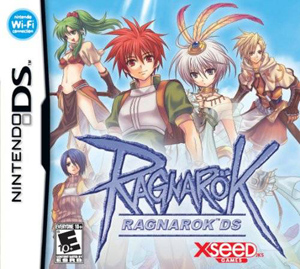
Ragnarok DS, known in Japan as Ragnarok Online DS, is a Nintendo DS video game based on the MMORPG Ragnarok Online and was released in Japan on December 18, 2008. Xseed Games published the game in North America on February 16, 2010. The game was also released in South Korea in June 2009.

Tales of Innocence is an action role-playing game, developed and released for the Nintendo DS and PlayStation Vita. Innocence is the ninth main installment in the Tales series, developed by Alfa System and published by Bandai Namco Games. It was released in December 2007. A remake for the Vita developed by 7th Chord, Tales of Innocence R, was released in January 2012. Multiple elements are carried over from previous entries in the series, including the action-based Linear Motion Battle System. Innocence R includes both an updated battle system and additional story content. Both versions remain exclusive to Asia.

Blue Dragon Plus is a role-playing video game designed by Mistwalker and developed by feelplus and Brownie Brown. It was published by AQ Interactive in Japan on September 4, 2008, and by UTV Ignition Entertainment on February 24, 2009 in North America. It is the second of three games in the Blue Dragon series, and the first of two for the Nintendo DS.

Harvest Moon DS: Sunshine Islands, is a video game that was released on February 21, 2008 in Japan and November 10, 2009 in North America. The seventeenth installment of the Story of Seasons series, and the fourth available for the Nintendo DS, the game closely resembles Harvest Moon DS: Island of Happiness; a section of the island from Harvest Moon: Island of Happiness is one of multiple islands in this game. The player can choose to be a boy (Mark) or a girl (Chelsea).

Soma Bringer is a 2008 action role-playing game developed by Monolith Soft and published by Nintendo for the Nintendo DS. The player, controlling one of the eight main characters, explores dungeons and fights enemies in real-time combat across three-dimensional plains from a top-down perspective. Multiplayer functions allow up to three players to participate in exploration and combat. The story takes place on the continent of Barnea, where its principle magical energy, Soma, is disrupted by the arrival of monsters called Visitors. This prompts a military group called Pharzuph Division 7 to defeat the Visitors and restore the balance of Soma.

Sands of Destruction is a role-playing video game developed by Imageepoch and published by Sega for the Nintendo DS. It was released in Japan in 2008, and in North America in 2010. The story revolves around a young man, Kyrie, who possesses the power to destroy the world, though he does not know why. The female lead is Morte, a member of a group that is trying to destroy the world.

Pokémon Platinum Version is a 2008 role-playing video game developed by Game Freak and published by The Pokémon Company and Nintendo for the Nintendo DS handheld game console. It is the third version after Pokémon Diamond and Pearl and is part of the fourth generation of the Pokémon video game series. It was released in Japan on 13 September 2008, and later in North America, Australia, and Europe in 2009.
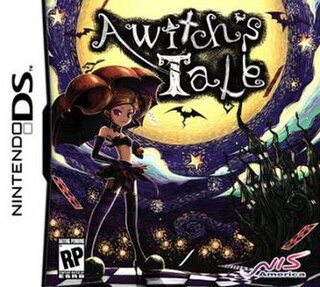
A Witch's Tale, released in Japan as Witch Tale: The Apprentice Witch and the Seven Princesses, is a video game for the Nintendo DS. It was published by Nippon Ichi Software and developed by Hit Maker. The game was initially planned for a Winter 2008 release, but was pushed back to 2009.

Harvest Moon DS: Grand Bazaar, known in Japan as Bokujō Monogatari: Yōkoso! Kaze no Bazaar e, is a simulation role-playing video game released on December 18, 2008 by Marvelous Interactive in Japan, and released on August 24, 2010 by Natsume Inc. in North America. It was released in Europe on September 30, 2011 by Rising Star Games. The game is the nineteenth game in the Story of Seasons series and the fifth game in the series for the Nintendo DS.
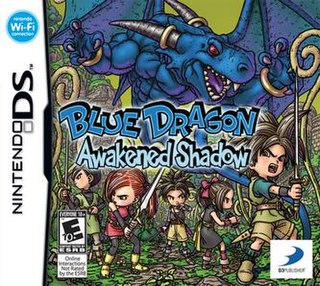
Blue Dragon: Awakened Shadow is an action role-playing video game developed by Mistwalker and tri-Crescendo and published by Namco Bandai in Japan and Europe and D3 Publisher in North America, for the Nintendo DS video game console and is part of the Blue Dragon series, its third installment and is a direct sequel to both Blue Dragon and Blue Dragon Plus. Hironobu Sakaguchi, Akira Toriyama and Hideo Baba are involved in the development of the game. It was released in Japan on October 8, 2009, in North America on May 18, 2010, and in the PAL region in September of the same year.
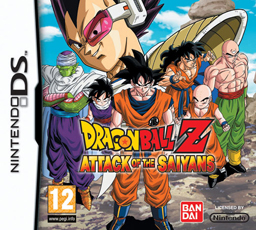
Dragon Ball Z: Attack of the Saiyans, known in Japan as Dragon Ball Kai: Saiyan Invasion, is a video game based on the Dragon Ball franchise for the Nintendo DS. It was released in Japan on April 29, 2009, and in Europe and North America in November 2009. The game is developed by Monolith Soft and distributed by Namco Bandai in North America ; it is one of the first games in the Dragon Ball franchise to be published by Namco Bandai, as the company would acquire the license from previous holder Atari in July of the same year.

Xenoblade Chronicles is an action role-playing game developed by Monolith Soft and published by Nintendo for the Wii. Initially released in Japan in 2010, it was later released in the PAL regions in 2011 and in North America in 2012. A port for the New Nintendo 3DS was released in 2015, and a remaster for the Nintendo Switch, titled Xenoblade Chronicles: Definitive Edition, was released in May 2020. Xenoblade Chronicles is the first entry in the Xenoblade Chronicles series, a subseries which forms part of the larger Xeno metaseries. Although it lacks direct narrative connections to previous Xeno games, like them, it incorporates aesthetic and narrative elements from both fantasy and science fiction. The game features navigation through an open world split into zones, side-quests tied to party members' affinity, and a real-time action-based battle system which incorporates Shulk's ability to see brief glimpses of the future.

Ni no Kuni: Dominion of the Dark Djinn is a role-playing video game developed and published by Level-5. It was released in Japan for the Nintendo DS on December 9, 2010. Players control Oliver, a young boy who sets out on a journey to save his mother. The game is played from a third-person perspective and its world is navigated on foot or by boat. While players navigate Oliver throughout the game's world, other characters can be controlled during battles against enemies; during these battles, players use magic abilities and creatures known as "imajinn", which can be captured and tamed.

Paon DP Co., Ltd. (株式会社パオン・ディーピー) is a Japanese video game developer. The company was founded in August 2004 as DP Inc. and merged with Paon Corporation, Ltd. in March 2015 to form Paon DP.
